The Indian glass fish is renowned for its striking feature: transparent scales that reveal its internal structure, including bones and organs. This fascinating river inhabitant captivates aquarists, making it one of the most sought-after species in home aquariums. Its unusual appearance, coupled with its gentle nature, makes it an intriguing choice for those looking to add a unique touch to their aquatic displays.
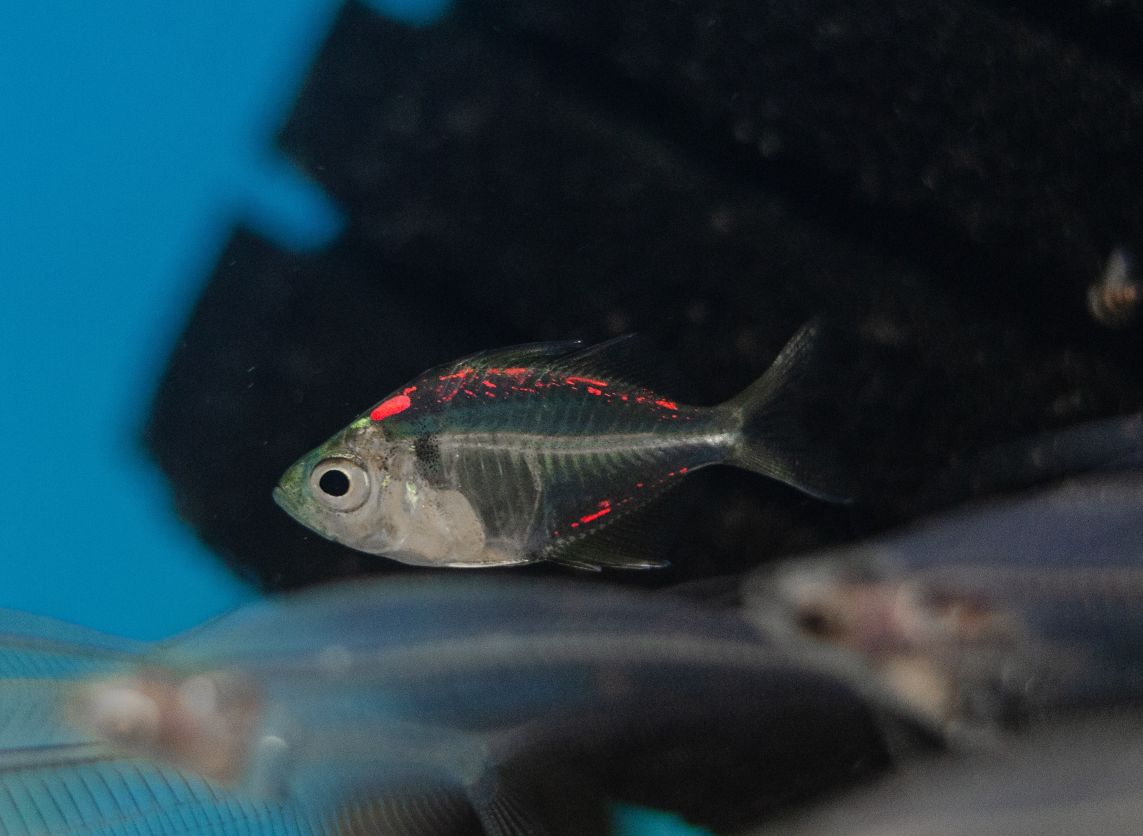
Contents
Habitat in the wild
The Indian glass fish is a captivating member of the Ambassidae family, often recognized for its transparent, glass-like appearance that reveals its internal organs. This unique feature makes the Indian glass fish a favorite among aquarists, as it represents one of the most notable species in its family, which includes small to medium-sized fish typically found in freshwater and brackish environments across Asia.
Historically referred to by the genus name Chanda, the Indian glass fish was once considered a monotypic species. However, with the discovery of additional similar species, the genus was renamed Parambassis, which now includes over ten recognized species, depending on the source.
Taxonomic classifications are subject to change as new research emerges, so it’s essential to consult current scientific literature or experts for the latest information.
Native to South Asia, the Indian glass fish thrives in the slow-moving waters of rivers, streams, and ponds in India, Bangladesh, and Nepal. In the wild, they are often found in brackish habitats along the Indian coast, favoring environments like rice fields and small ponds where they can hide among overhanging vegetation and fallen leaves. These fish prefer calm waters with dense plant life, as their transparent bodies help them blend into their surroundings, providing protection from predators.
Introduced to Europe in 1905, the Indian glass fish was quickly adapted for tank breeding, establishing its popularity in home aquariums. With their unique appearance and peaceful nature, they continue to be a fascinating choice for aquarists looking to create a vibrant and diverse aquatic environment.
Description
The Indian glass fish derives its name from its remarkable transparent tissues, particularly evident in younger individuals. This transparency allows observers to see its skeleton and the shiny covering of its visceral organs and gills. This unique feature serves as camouflage, helping the fish evade potential predators. Unlike other transparent fish, the Indian glass fish does not possess transparent eyes or digestive tracts, which are instead covered with a glassy layer.
In the wild, Indian glass fish typically reach a length of about 7 to 8 centimeters (approximately 2.7 to 3.1 inches) when fully mature. However, they tend to grow smaller in aquarium settings, with individual sizes varying due to factors like genetics, diet, and living conditions.
In captivity, these fish generally have a lifespan of 2 to 3 years, although some may live longer under optimal conditions. Lifespan can be influenced by various factors, including water quality, diet, tank size, and overall care. For instance, higher water temperatures can accelerate metabolism, potentially leading to a shorter lifespan.
Painted glass fish
Some suppliers in Asia, seeking profit, engage in the unethical practice of enhancing fish appearance by injecting dyes, believing that the natural colors are unappealing. This results in fish with bright pink, yellow, and green stripes. Unfortunately, the dyeing process is harmful to the fish’s immune system, leading to high mortality rates shortly after the procedure. Those that survive often suffer from various diseases as a consequence of the stress and trauma inflicted during the process. Additionally, the artificial colors typically fade over time, rendering the alterations temporary.
It is crucial to recognize that this practice is widely condemned for its harmful effects on fish health. Injecting or dyeing fish not only stresses them but also disrupts their natural biology and immune responses. As responsible aquarium enthusiasts, it is vital to avoid supporting the trade of dyed or artificially colored fish. Always choose reputable sellers who prioritize the well-being of their fish and advocate for ethical practices within the aquarium hobby. By doing so, you contribute to a more humane and sustainable aquarist community.
| Characteristic | Description |
|---|---|
| Scientific Name | Parambassis ranga |
| Common Name | Indian Glass fish; clear fish |
| Family | Ambassidae |
| Habitat | Freshwater rivers, streams, and ponds in South Asia |
| Native Range | India, Bangladesh, Nepal |
| Size | Up to approximately 7-8 cm (2.7-3.1 inches) |
| Body Color | Transparent or translucent with a silver sheen |
| Behavior | Generally peaceful, prefers schooling |
| Diet | Carnivorous, feeds on small invertebrates |
| Life Span | Typically 2 to 3 years in captivity |
| Compatibility | Generally peaceful and suitable for community tanks |
| Tank Requirements | Adequate hiding spots, live plants, and open space |
| Water Parameters | Temperature: 22-28°C (72-82°F); pH: 6.5-7.5 |
| Breeding | Egg-scattering species, no parental care |
| Special Considerations | Due to their transparency, avoid housing with aggressive tankmates or brightly colored decor |
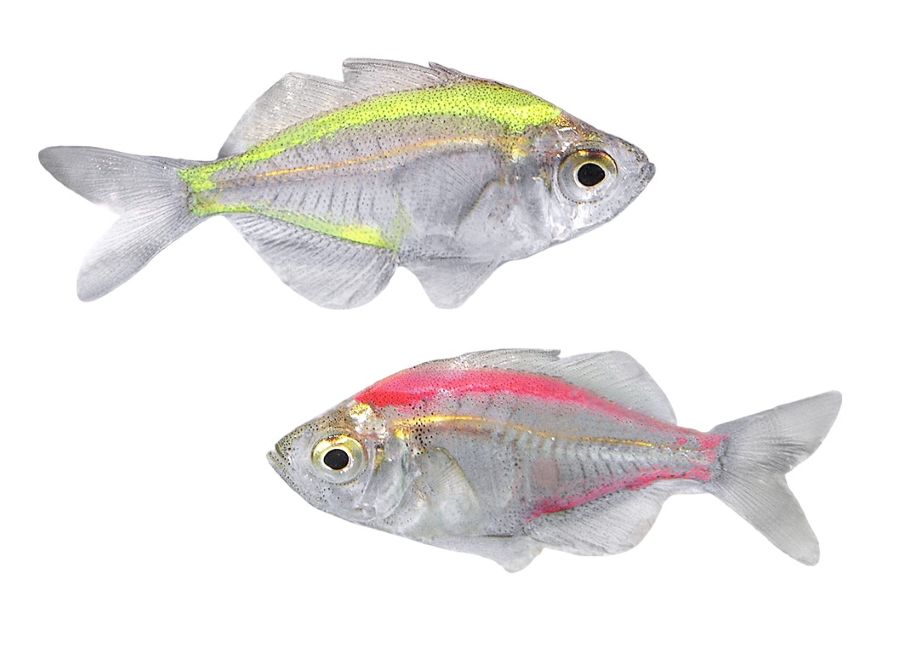
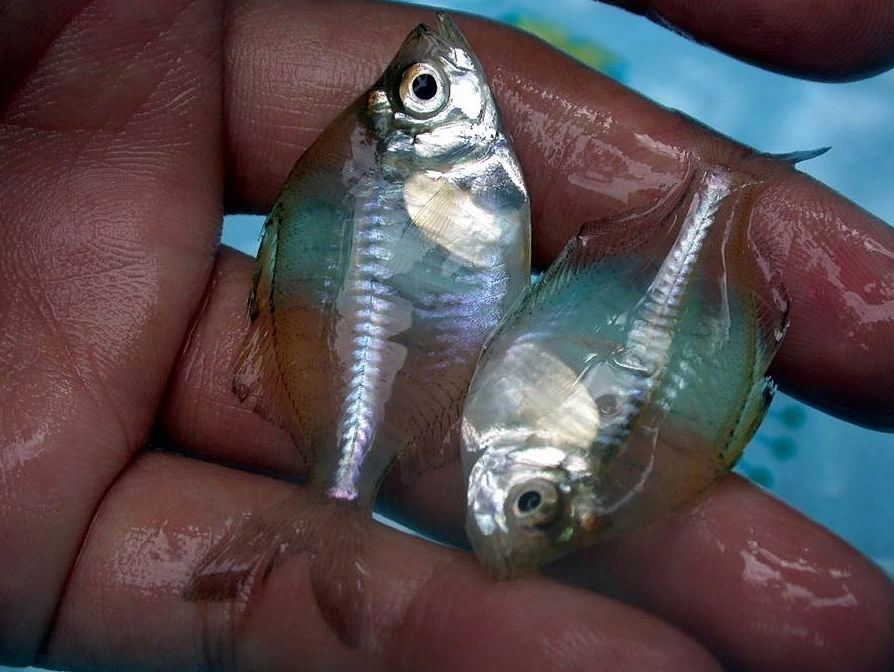
Difficulties in keeping
The Indian glass fish is a delicate species that has become increasingly demanding in care due to environmental changes and human impacts. Unfortunately, these factors contribute to a shorter lifespan for these fish. It is particularly important to avoid purchasing dyed fish, as they not only have a reduced lifespan but also experience rapid fading of their artificial colors. Supporting ethical practices in the aquarium trade is essential for the well-being of these unique fish and for preserving their natural beauty.
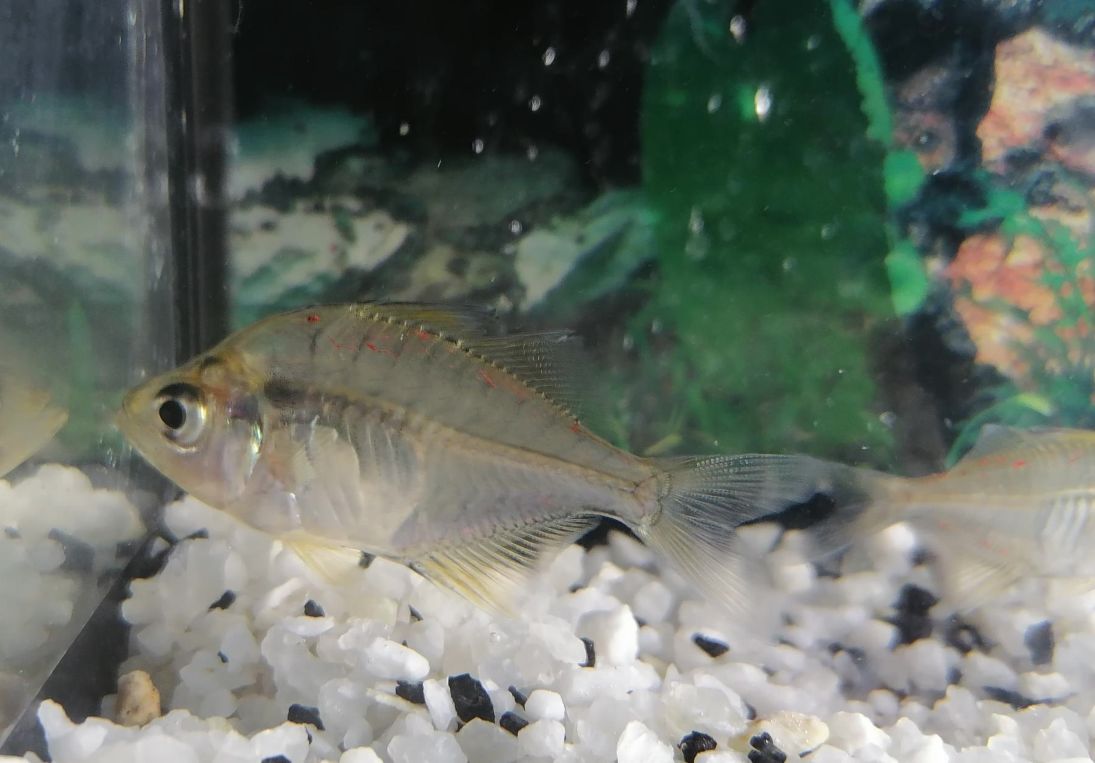
Care and keeping in a tank
Tank size
The tank size for Indian glass fish is crucial and should be determined by the number of fish you plan to keep, as well as whether you intend to maintain a community tank or a species-specific setup. Generally, a minimum tank size of 20 to 30 gallons (75 to 113 liters) is recommended for a small group of these fish.
An important consideration is not just the tank’s capacity but its square area. Ideally, the tank height should not exceed 20 cm (8 in). It should feature two distinct areas: one open space for swimming and another that is densely planted with shelters, as Indian glass fish are quite timid.
Remember that a larger tank generally promotes better health and well-being for the fish. It allows them more room to swim, explore, and interact.
Water parameters
Indian glass fish do not have particularly demanding requirements for water composition, but maintaining stable conditions is crucial for their well-being. The recommended water parameters include a pH of 6.5 to 8.5 (ideally not exceeding 7.5), general hardness of 8 to 25 °dGH (with 10 to 12 °dGH being optimal), and a temperature range of 23 to 26 °C. Ammonia and nitrite levels should remain at 0 ppm, while nitrate levels should be below 20 ppm, ideally under 10 ppm. Regular water filtration, aeration, and a weekly water change of about one-third of the tank volume are essential.
More important than the specific values of these parameters is their stability, as Indian glass fish are sensitive to fluctuations. It is best to introduce them to a tank that has established a stable biotic balance.
While Indian glass fish are generally hardy, sudden changes in water parameters can lead to stress and make them more vulnerable to diseases. Proper acclimation is crucial when introducing them to a new aquarium.
Changes in their habitual water parameters can be particularly challenging for Indian glass fish, especially for wild specimens. Care should be taken when renewing water to ensure that the new water closely matches existing parameters. Monitoring the fish’s reactions during this process can help you make necessary adjustments.
Tank setup: decorations and plants
A well-planted tank is essential for the health and comfort of Indian glass fish. It should feature short, small-leaved plants positioned near branchy snags and stones to create hiding spots and a natural environment. In the background, consider using long-stalked plants like cabomba, hornwort, and vallisneria to add depth and visual interest.
For the substrate, a dark-colored bottom is preferable. Large-grained gravel or sandy substrate works well for this purpose, as it complements the overall aesthetic and helps the fish feel secure. Thoughtful aquascaping not only enhances the beauty of the aquarium but also provides essential hiding places, reducing stress for the fish.
Filtration and water changes
Maintaining clean water with stable parameters is essential for the health of Indian glass fish, making a canister filter an excellent choice for filtration. Regularly monitoring water quality with reliable test kits is crucial to ensure that all parameters remain within the appropriate range.
To maintain water quality and remove accumulated toxins, perform regular water changes of about 20 to 30% of the tank volume. For new fish, it’s advisable to conduct 2 to 3 small water renewals per week (around 5% of the total volume) during the first 2 to 3 months. Once the fish acclimate and show no signs of stress, you can switch to a standard routine of changing 15 to 20% of the water once a week.
Diet
In the wild, they feed on various spineless species, including worms, shellfish, maggots, and crustaceans. When kept in an aquarium, they thrive on high-quality dry food that is well-balanced, contains functional additives, and poses no risk of introducing pathogens to the tank.
Indian glass fish also eagerly accept live foods such as brine shrimp, mosquito larvae, daphnia, and small worms like bloodworms and blackworms. These live foods are highly nutritious and closely resemble their natural prey, providing essential dietary benefits.
As these fish prefer to feed in the upper and middle water layers, it’s best to use floating foods or those that sink slowly. This feeding strategy not only meets their nutritional needs but also mimics their natural foraging behavior, promoting a healthier and more active lifestyle.
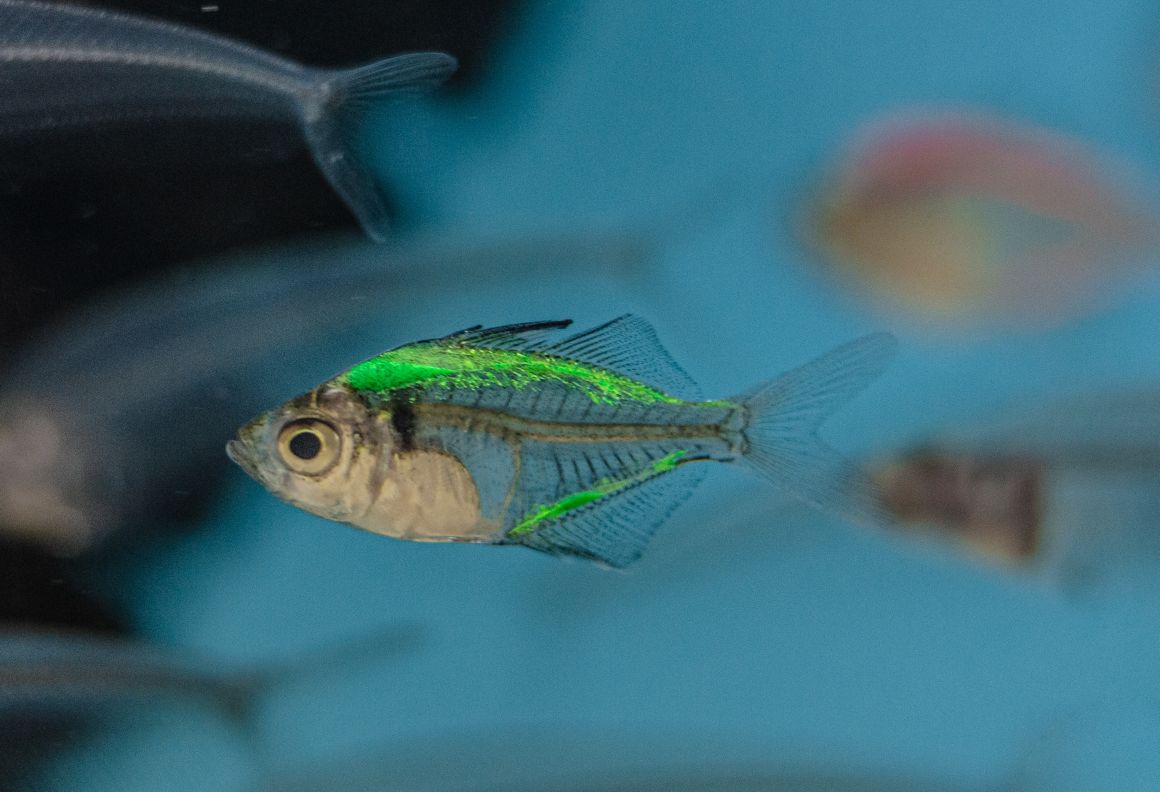
Tank mates
Indian glass fishes are schooling ones, and it’s desirable to keep at least 5-6 of them in the tank. These better be young fishes, not longer than one inch. In this case, they’ll always stay in a school swimming among stones and plants. Only when living in a school do they demonstrate their behavior and decorative features in its full.
You should keep in mind, that in a small tank with many fishes, indian glass fishes behavior can’t be seen in its full, so it is recommended to keep them in rather spacious tanks.
Species that live alone or in small groups become timid. They constantly try to hide and have a poor appetite.
Any small peaceful fishes will do as indian glass fishes tank mates. So, it’s not an issue to select tankmates for them in a community tank. These are totally calm and timid fishes, and they can’t be kept with large and aggressive fish species.
Harlequin rasbora, zebra danio, white cloud mountain minnow, sparkling gourami, rummy nose tetra, dwarf pencilfish, dwarf gourami will be perfect tank mates for glass fishes.
Peaceful catfishes (hoplo catfish, otocinclus catfish, Corydoras julii, panda cory) will also make a good company to glass fishes. They also won’t hurt shrimps: Amano shrimp, cherry shrimp, and glass shrimp. If you plan to keep indian glass fishes in brackish water, then guppy fish, molly fish, bumblebee goby will do as tank mates since they easily stand such conditions.
Gender differences: male vs female
Understanding sex dimorphism is essential for breeding Indian glass fish, as they reach reproductive maturity at about six months of age. At this stage, males display vibrant golden coloration, which can become orange-yellow with a specific diet. Their unpaired fins feature striking blue edges, and their air bladder appears more elongated compared to females.
In contrast, females exhibit a paler coloration, typically silvery with a yellowish tint. They are generally larger and have a slightly rounder abdomen, indicating their readiness for breeding.
Recognizing these differences not only aids in identifying male and female fish but also enhances your chances of successful breeding in an aquarium setting. Proper conditions and diet can further encourage their reproductive behaviors, leading to a thriving population of Indian glass fish.
Breeding
Before spawning, indian glass fish males and females are put in separate tanks for a week. And add settled for at least a week fresh water into their tanks. The water temperature is raised to 26-28°C. During all this time, the fish should have a diversified and nutritious diet.
As a spawning tank, you can use a small volume half-filled with fresh, settled water, without a separating net and with a large bush of a small-leaved plant, for example, java moss, or its synthetic analog, which is used as a spawning substrate.
The indian glass fish don’t have any specific requirements for the water composition. Its temperature should be maintained at about 26-28°C.
Indian glass fishes may have spawning both in couples and in groups. So, you put a couple of breeders or one male and two females into the prepared spawning tank. At that, the females should have rounded abdomens and the male – active and bright-colored.
If the spawning occurs in a community tank, a male ready for spawnings usually swims near a bush of a small-leaved plant, and this spot and the surrounding territory become its territory which he guards against his tank mates.
If a female swims into his territory, he starts showing interest to her in the form of some spawning dance and invites her to join the spawning process.
The spawning lasts for about 4 days. The females lay eggs in small portions of 3-6 eggs which the male fertilizes at the same time. During the day, they spawn many times, and it is recommended to feed the fish with fresh live food. This has a good influence on the fish and keeps them active.
Most of the eggs stick to the plants, and only a small number of them fall on the tank bottom. During the spawning period, the female can lay up to 500 eggs. Adult fishes don’t eat their eggs or juveniles. Once the spawning is over, you should remove the breeders from the spawning tank since they don’t participate in their offspring’s further development.
Approximately in 26 hours, very small (bout 1.5 mm long) colorless larvae hatch from the eggs. For about three more days, they hang on the tank plants and walls, feeding on their yolk bags, and after this, they start swimming and searching for food.
Newly hatched brine shrimp nauplii can be used as start food for the juveniles. They usually have a good appetite; thus, you should prepare enough food of the corresponding size. You should feed the juveniles with small portions of food several times a day by bolting it through a sieve with cells of the corresponding size. Because when trying to swallow a too-large piece of food, the juvenile can die.
Moderate water flow ensures that the food moves since it is easier for the school of juveniles to catch it when it flows by.
The first two weeks of the juvenile life are the most crucial in indian glass fishes life. During this period, you shouldn’t let the tank water temperature get low since the juveniles become less active, stop eating, and then die. Stable water temperature and high-quality food guarantee successful growth of the juveniles and a very insignificant death cases percentage. It is recommended to have 24/7 dim lighting and that the tank water level doesn’t exceed 20 cm.
The juveniles grow quite fast, and at the age of 3 months, you can see if they are males or females.